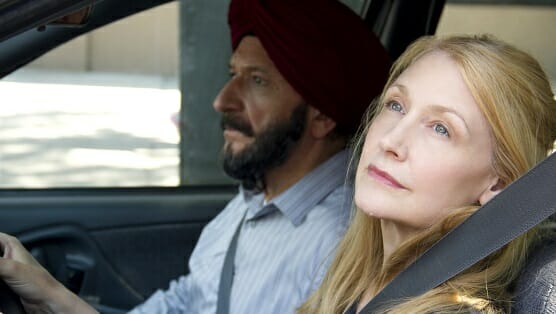
Learning to Drive is a cross-cultural comedy-drama about Wendy (Patricia Clarkson), a recently divorced Manhattanite, and her Sikh driving instructor Darwan (Ben Kingsley), who trade advice and life lessons while cruising New York’s emptiest streets. It’s reminiscent of Driving Miss Daisy, a film with another odd coupling that develops behind the wheel. But in director Isabel Coixet’s (My Life Without Me, Elegy) latest feature, the female protagonist has evolved from Miss Daisy’s era: Ms. Wendy is learning to drive herself. The film’s neither flashy nor groundbreaking, and despite its derivative nature, Learning to Drive will resonate with a demographic of a certain age, thanks to the engaging performances by the leads and supporting cast.
The film opens on Kingsley, in a full beard and turban, as he imparts aphorisms like “Driving is a freedom” or “Enjoy freedom without hurting anyone” to a young driver who’s about to take the test for his license. For better or worse, it’s hard not to relate the calmness and sagacity in his voice to Kingsley’s indelible, Academy Award-winning performance as Gandhi. The similarities don’t end there: Darwan is also a spiritual man, a former university professor who sought political asylum in the U.S. after being persecuted and jailed in India. He lives a modest life, working as a driving teacher by day and a cab driver at night, and spends much of his free time praying at a Sikh temple in Queens. Darwan shares a crowded apartment with other male immigrants, some with their papers in order and others—like his nephew Preet (Avi Nash)—in the country illegally.
Wendy, a book critic and a member of the public radio cognoscenti, first meets Darwan when she and her soon-to-be ex-husband Ted (Jake Weber) hop into the back of his cab, spewing vitriol at each other. The fight is intense, with Weber and Clarkson going at each other full tilt. Ted’s in the midst of his third seven-year itch, but this time he finally wants out of the marriage. Wendy’s been blindsided—and now she’s pissed. When Ted complains that she’s been looking through him for years, favoring her books instead, she screams, “I”m looking through you right now … and you’re a prick.”
To reclaim her independence and self-worth, Wendy decides to learn how to drive. Born and raised in the city, she relied on Ted or public transportation to get around. Now that her daughter (Grace Gummer, a ringer for her mother Meryl Streep) has moved to Vermont to work on a farm, she makes it a goal to drive to visit her. Darwan becomes Wendy’s sensei through the city, teaching her how to focus on the road immediately in front of her, and not get too distracted along the way. Kingsley’s delivery of these platitudes makes up for the lack of subtext. During their lessons, they open up—just a little—about their families and lives. Wendy talks about her father who abandoned the family, and Darwan surprises Wendy (and the audience) when he suddenly rushes off to the airport to pick up Jasleen (Sarita Choudhury), a woman his sister selected to be his wife.
The similarities to Driving Miss Daisy become most apparent when Darwan is subjected to religious and racial slurs. He doesn’t react or engage when he’s taunted for being a Muslim or a terrorist, and Wendy, a lifelong New Yorker, who presumably lived through 9/11, is surprisingly shocked when she learns the attacks on her new friend are a near daily occurrence.
Under Coixet’s direction, Learning to Drive meanders along in the slow lane, illuminating the life changes for these friends. While Wendy does have a few sassy lines and zingers—usually aimed at Ted—in Sarah Kernochan’s screenplay, some of the film’s most interesting moments are the quiet ones that introduce us to the Sikh culture, from the use of the turban to the beauty of its religious ceremonies. Aside from the heated exchanges between Ted and Wendy, the stillness of the Sikh temple and the driving in Manhattan traffic, there’s not a lot of drama or tension to the 89-minute film, making it feel much longer.
Coixet also includes a few scenes in which Wendy imagines conversations with Ted, and then her father; the fantastical elements are oddly out of place with the rest of her uber-realistic storyline. If anything, it’s Darwan’s past as a political prisoner that could have been worth exploring briefly in flashback.
About halfway through the film, Darwan’s new wife becomes an unintended third wheel to their friendship. Hailing from a small village in India, Jasleen is barely literate, and Darwan, like Wendy, is a man of poetry and letters. Kernochan and Coixet occasionally steer the film into “Will they or won’t they?” territory, but it’s distracting. Both characters are mature enough to maintain a platonic friendship. (Believe it or not, Hollywood, it does happen in real life.) A scene during the film’s denouement seems ripped from a typical romantic dramedy playbook and feels out of step for Darwan.
Both Wendy and Darwan are familiar cinematic archetypes, yet the performances keep the film from becoming too preachy or maudlin. Clarkson has a few scenery-chewing moments during divorce proceedings at the beginning of the film, but she dials it back enough to give a realistic portrayal of a woman who finds herself starting over after decades in the same relationship and routines. Kingsley’s performance complements her angst with composure. Together they show how these two different people would come to rely on each other as they reach major turning points in their lives. This innocuous film will surely appeal to those who have experienced the same.
Director: Isabel Coixet
Writer: Screenplay by Sarah Kernochan, based on a New Yorker essay by Katha Pollitt
Starring: Patricia Clarkson, Ben Kingsley, Jake Weber, Sarita Choudhury, Grace Gummer
Release Date: August 21, 2015 in select theaters
Christine N. Ziemba is a Los Angeles-based freelance pop culture writer and regular contributor to Paste. You can follow her on Twitter.